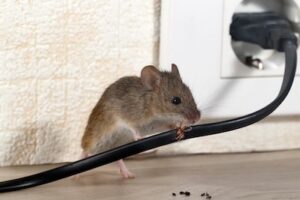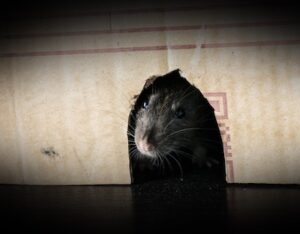How To Know You Have Rats In Your Home
Rats are not just cute, furry little creatures that make great pets. They can also be a big problem for you and your family. Rat infestations are common in homes, especially if your home is located in an area with access to water and food. So how do you know if you have rats in your house?
The best way how to know you have rats in your home is to look for these common signs:
- Rat Droppings
- Urine Stains
- Rub Marks
- Gnaw Marks
- Rat Holes
- Rat Nests
- Runaways
- Footprints
- Noises
- Pet Behavior
If you think rats might be living in your home, it’s important that you identify all of the signs of rat infestation, so that pest control service Los Angeles can take action before they cause any damage or spread disease. So, now that you know some of the most common signs of rats, let’s look at each of these signs more in-depth.

1. Rat Droppings
Rats leave behind droppings wherever they go, so look for signs of them in areas where there isn’t a lot of foot traffic. You might find them under furniture, inside cabinets and drawers, or even behind the stove! Rat droppings are about half an inch long, black or brown in color with tapered ends. They look like little grains of rice or pellets.
2. Urine Stains
Rats leave behind urine stains as they walk through a room or area. These stains look like black or brown spots and can often be found on the floor near walls or furniture so don’t forget to look out for these as well. If you start noticing urine stains on your walls or floors then this could mean that there’s been rodent activity going on inside your home! The urine stains may also smell pretty bad too (like ammonia) so make sure to check these areas out carefully before deciding whether or not there really is an issue here!
3. Rub Marks
Rats love to climb walls and furniture, so when they climb up onto something smooth like wood or metal it can leave behind dark smudge marks that resemble fingerprints with clear impressions from the rat’s fur and claws. The marks will be vertical lines created by their front paws while climbing. While the bottom half is made up of horizontal lines from the back paws sticking out from underneath the belly as they walk along flat surfaces like floors or counters.
4. Gnaw Marks
If you see gnaw marks on your walls, it’s a strong sign that rats have been in your home. They can be found anywhere from the basement to the attic, but are usually most common near food sources such as pet food or garbage cans. The marks may be small and hard to spot at first, but once you know what to look for they’re obvious. Rats use their teeth to tear through cardboard boxes and paper bags, so if you see any holes in these items it’s likely there are rats in your home!

5. Rat Holes
Rats make holes in walls, floors, and ceilings when they are exploring them for new places to hide or nest. These holes are usually about 10cm wide and can have smooth edges from where the rats have chewed away at the wood with their sharp front teeth. The types of materials that rats chew depend on what is available – for example, if there is plenty of food available in your kitchen then you may find that they’ve eaten through soft plastic fittings such as pipes or telephone wires instead of chewing through solid wood structures like walls or floors!
6. Rat Nests
Rats make nests out of materials like cardboard, paper, and even insulation for their young or for sleep during the day when people are awake and around the house more often than at night when it’s quietest for them after everyone goes to bed or gets home from work/school, etc. You’ll usually find these nests near where rats enter your house (hiding places like under stairs or behind furniture) so keep an eye out for things like that!
7. Runways
Rats will use “runways” to get from one place to another. They’re usually in corners, behind or under appliances and furniture, and along walls. If you find runways, chances are good that rats are living somewhere nearby.
Look along the edges of your property for holes where rats could enter and exit your home, or check around trees or bushes that might provide cover for rodents during the day. If you find any holes or cracks in these areas then make sure they are sealed up so that rats cannot get into them anymore!
8. Footprints
Rats leave footprints that look like small fingerprints when they walk on smooth surfaces such as wood floors or linoleum tile floors. The prints can be hard to see if there isn’t much light so make sure you look into dark corners where there might be less dust or dirt on the flooring surface so you can see them better!
9. Noises
Rats make noises that are different from other noises in your house. They squeak, squeal, whistle, and chirp when they are excited or angry. You may hear these noises at night when you’re trying to sleep or during the day when no one else is home. Rats also make scratching sounds as they run around your walls and floors searching for food or shelter.
10. Pet Behavior
If any of your pets start acting differently, chances are there is something going on with them too. Cats will hide more often than usual, dogs may become aggressive towards other animals outside on walks or even inside the house if they smell rats nearby (and some dogs will bark at nothing), while cats may scratch at the furniture more often than usual due to stress from being surrounded by rats nearby.

Precautions To Limit Household Exposure
Rodents are everywhere, and they’re not going away. The good news is that there are steps you can take to minimize the risk of rodent exposure, both inside and outside the home.
Here are 3 precautions you can take to limit rodent exposure:
1. Keep food and water sources away from areas where rodents might be able to get to it—especially during warm weather when they are more active and hungry than usual (rodents will be looking for food and water sources during this time).
2. Make sure all holes or openings in walls or floors have been sealed shut so rodents cannot enter your home through them. You’ll want to pay particular attention to gaps around pipes or wires that might be coming into contact with soil outside the building’s foundation (these areas can provide safe passage for rodents into your home).
3. Remove any items lying around in hard-to-reach places where rodents could easily find them—like piles of debris under decks or sheds where they live (this will make it harder for them to find food sources outside your home).
Final Thoughts
Rats can be cute when they’re not eating your food or chewing through your walls. They’re also very smart animals so you need to take appropriate measures from preventing them from getting comfortable in your home. We hope this guide has given you the tools you need to spot signs of rodent infestation and prevent exposure in your house. If not, at least now you know what it looks like when rats are in your house—and that’s half the battle!
